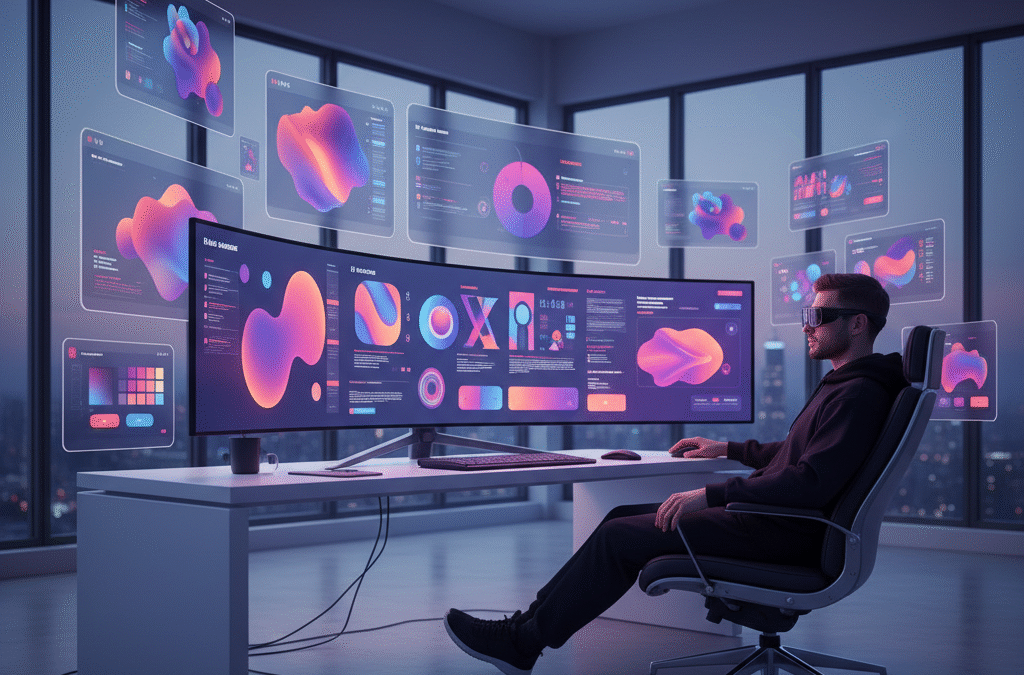The web in 2025 isn’t what it used to be. It’s smarter, faster, more human and far less forgiving.
As a digital marketing freelancer in Chennai who has followed web design for over a decade, I can tell you this: 2025 isn’t about flashy visuals or fancy effects anymore. It’s about creating digital experiences that adapt, communicate, and feel real.
Brands that get this will win. Those who cling to outdated templates will fade into digital noise. After analysing dozens of award-winning sites, agency portfolios, and UI shifts, here are the 30 web design trends that will dominate 2025 — and how you can actually use them to your advantage.
Contents
- 0.1 1. AI-Driven Design Systems
- 0.2 2. Adaptive UX
- 0.3 3. Motion as a Narrative
- 0.4 4. Minimalism with Emotion
- 0.5 5. Immersive 3D and WebGL Elements
- 0.6 6. AI-Personalised Websites
- 0.7 7. Voice-Activated Navigation
- 0.8 8. Dark Mode Everything
- 0.9 9. Glassmorphism and Frosted Layers
- 0.10 10. Brutalism Reimagined
- 0.11 11. Inclusive and Accessible Design
- 0.12 12. Cinematic Hero Sections
- 0.13 13. Generative Backgrounds
- 0.14 14. Emotional Microinteractions
- 0.15 15. Bold, Variable Typography
- 0.16 16. Scroll-Driven Storytelling
- 0.17 17. Split-Screen Design
- 0.18 18. Sustainable Web Design
- 0.19 19. Horizontal Scrolling Experiences
- 0.20 20. Interactive Data Visualisations
- 0.21 21. WebAR (Augmented Reality)
- 0.22 22. Story-Based Navigation
- 0.23 23. Human-Centred Photography
- 0.24 24. Hyper-Local Design Personalisation
- 0.25 25. Gamified UX
- 0.26 26. Minimal Navigation
- 0.27 27. AR-Powered Product Previews
- 0.28 28. Zero-UI Interfaces
- 0.29 29. Real-Time Collaboration
- 0.30 30. AI-Powered Content Blocks
- 1 💡 Advanced Web Design Trends Strategies
- 2 ⚠️ Common Mistakes to Avoid
- 3 Conclusion: The Future Belongs to Experience-Driven Design
1. AI-Driven Design Systems
AI isn’t just writing content anymore — it’s designing layouts. Tools like Figma’s AI, Uizard, and Framer’s AI assistant can generate entire wireframes in seconds.
Why it matters: Designers can focus more on creativity than on coding pixels.
How to use it: Start with AI-generated drafts, then refine them with your creative direction.
💡 Tip from a digital marketing freelancer in Bangalore: AI can help speed up client website mockups while keeping quality intact.
2. Adaptive UX
Web design in 2025 will be context-aware. Sites will automatically adjust layouts, tone, and visuals based on user behaviour or environment.
Pro tip: Combine analytics with AI tools to deliver dynamic personalisation.
3. Motion as a Narrative
Motion tells stories. From scroll-triggered animations to microinteractions, movement now drives emotion and engagement.
Real-world use: Apple’s AirPods site uses scroll animation to tell a story visually — no long paragraphs, just flow.
Pro tip: Tie every animation to a purpose. If it doesn’t enhance understanding, skip it.
4. Minimalism with Emotion
Minimalism isn’t just clean — it’s now emotional. 2025 minimalism uses soft shadows, warm gradients, and human-centred typography.
5. Immersive 3D and WebGL Elements
Thanks to tools like Spline and Three.js, brands are now embracing 3D storytelling.
Use it for product previews or immersive user journeys — just ensure fallbacks for mobile devices.
💡 If you’re offering digital marketing services in Chennai, showcasing interactive 3D service visuals can instantly build trust and engagement.
6. AI-Personalised Websites
AI will personalise everything — from CTAs to banners — based on real-time user behaviour.
Action step: Integrate AI personalisation with your CMS for dynamic UX.
Voice UX is rising fast. By 2025, over 40% of site interactions will involve voice or sound.
Let users search or filter with voice commands — it’s more inclusive and faster.
8. Dark Mode Everything
Dark mode has become a user expectation. Design both dark and light versions for accessibility and aesthetics.
Tip: Don’t just invert colours — tweak shadows, contrasts, and imagery.
9. Glassmorphism and Frosted Layers
This web design trend gives depth while keeping things sleek — perfect for dashboards and SaaS designs.
10. Brutalism Reimagined
Big fonts, bold statements, and broken grids — but with purpose. 2025’s brutalism is deliberate, confident, and modern.
11. Inclusive and Accessible Design
Accessibility is not optional, it’s profitable. Sites with high contrast, keyboard navigation, and ARIA labels rank better.
💡 As a digital marketing freelancer in India, building accessible websites can greatly boost SEO and conversions for your clients.
12. Cinematic Hero Sections
Forget static banners — cinematic hero sections are in. Subtle motion and storytelling can instantly hook users.
Keep load times under 3 seconds, though — speed is king.
13. Generative Backgrounds
AI-generated backgrounds that adapt per visitor are redefining web personalisation.
14. Emotional Microinteractions
Those small animations when users click or scroll? They’re becoming emotional, reacting to mood, time, or weather.
Use Lottie animations for responsive, lightweight results.
15. Bold, Variable Typography
Typography in 2025 is most valuable web design trends, which is flexible and alive. Variable fonts can animate and adjust dynamically.
16. Scroll-Driven Storytelling
Scroll = story. Each scroll reveals animation or interaction.
Example: Spotify Wrapped 2024 — cinematic storytelling in every scroll.
17. Split-Screen Design
Split-screen layouts simplify complex content. Great for comparisons or dual branding.
18. Sustainable Web Design
Eco-friendly design is now mainstream — lightweight code, compressed images, and green hosting matter.
Each 1MB saved reduces carbon footprint — and improves load time.
19. Horizontal Scrolling Experiences
Used wisely, horizontal scrolling can make portfolios or product showcases stand out.
20. Interactive Data Visualisations
Embedding live dashboards builds trust instantly, especially for B2B and SaaS brands.
Tools like D3.js or Chart.js make this seamless.
21. WebAR (Augmented Reality)
Imagine previewing products directly in your environment via the browser.
Perfect for real estate, fashion, and eCommerce.
Menus that tell stories — interactive, conversational, and intuitive.
23. Human-Centred Photography
Real people, real emotions — no more lifeless stock photos.
Show your team, your workspace, and your process to humanise your brand.
24. Hyper-Local Design Personalisation
Websites that adapt based on location will dominate — serving unique visuals and offers per region.
25. Gamified UX
Gamification drives engagement — points, badges, and interactive challenges make users stay longer.
Hidden or floating navigation creates focus and simplicity.
27. AR-Powered Product Previews
Augmented reality makes shopping more interactive — users can “try” before buying.
28. Zero-UI Interfaces
Beyond screens — gesture, voice, and haptic feedback are redefining digital interaction.
29. Real-Time Collaboration
Imagine users co-creating wishlists or collaborating live — that’s the next step in interactive web UX.
30. AI-Powered Content Blocks
AI will rewrite headlines and offers in real-time, personalising web content dynamically.
💡 Advanced Web Design Trends Strategies
- Pick 3–5 trends that suit your brand personality.
- Focus on speed — aim for a 2.5s LCP or faster.
- Build reusable design systems for brand consistency.
- Prioritise accessibility — it’s great for SEO.
- Prototype fast and test often to stay agile.
⚠️ Common Mistakes to Avoid
- Overusing animations
- Ignoring accessibility
- Following trends blindly
- Skipping testing
- Neglecting mobile-first
Conclusion: The Future Belongs to Experience-Driven Design
2025 web design trends are redefining how brands connect with users, blending creativity, AI, and functionality into seamless digital experiences, it’s about transformation. It’s about crafting digital experiences that feel human, perform fast, and tell stories that stick.
Whether you’re a designer, developer, or digital marketing freelancer in Chennai helping small businesses grow, your website is your brand’s living, breathing presence.
FAQS
1: How do I choose the right 2025 web design trends?
Start with your audience. Creative brands may prefer 3D; SaaS firms might focus on speed and adaptive UX.
2: Are AI tools replacing designers?
No AI enhances human creativity.
3: Do web design trends affect SEO?
Yes. Accessibility, speed, and engagement directly improve rankings.
4: Should small businesses use AR?
Only if it adds value. Clean UX and fast load times often outperform complex tech.
5: How often should I redesign my site?
Every 18–24 months or when engagement drops.

